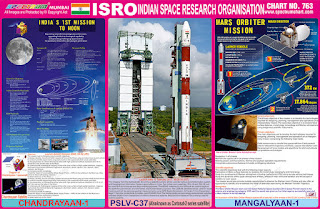 |
| ISRO - Indian Space Research Organisation Chart |
Spectrum Chart - 763 : ISRO - Indian Space Research Organisation
1. Chandrayaan 1 –
Chandrayaan-1 was India's first lunar probe. It was launched by the
Indian Space Research Organisation in October 2008 and operated until
August 2009. The mission included a lunar orbiter and an impactor.
India launched the spacecraft using a PSLV-XL rocket, serial number
C11, on 22 October 2008 at 00:52 UTC from Satish Dhawan Space Centre,
Sriharikota. The spacecraft was orbiting around the Moon at a height
of 100 km from the lunar surface for chemical, mineralogical and
photo-geologic mapping of the Moon. The spacecraft carried 11
scientific instruments built in India, USA, UK, Germany, Sweden and
Bulgaria.
2. PSLV-C37 – PSLV-C37, also
known as Cartosat-2 series satellite) was the 39th mission of the
Indian Polar Satellite Launch Vehicle (PSLV) program and its 16th
mission in the XL configuration. PSLV-C37 successfully carried and
deployed a record 104 satellites in sun-synchronous orbits. Launched
on 15 February 2017 by the Indian Space Research Organisation (ISRO)
from the Satish Dhawan Space Centre at Sriharikota, With this launch,
ISRO created a new world record for the largest number of satellites
ever launched on a single rocket, surpassing the previous record of
Russia, which in 2014 launched 37 satellites using Dnepr rocket. The
total cost of the mission was ₹1007.64 Crore (US$15 million).
3. Mangalyaan 1 - Mars Orbiter
Mission (MOM), also called Mangalyaan is a space probe orbiting Mars
since 24 September 2014. It was launched on 5 November 2013 by the
Indian Space Research Organisation (ISRO). It is India's first
interplanetary mission and ISRO has also become the fourth space
agency to reach Mars, after the Soviet space program, NASA and the
European Space Agency. It is the first Asian nation to reach Mars
orbit, and the first nation in the world to do so in its first
attempt. The total cost of the mission was approximately ₹450 Crore
(US$73 million), making it the least-expensive Mars mission to date.
The primary objective of the mission is to develop the technologies
required for designing, planning, management and operations of an
interplanetary mission. The secondary objective is to explore Mars'
surface features, morphology, mineralogy and Martian atmosphere using
indigenous scientific instruments. The mission would also provide
multiple opportunities to observe the Martian moon Phobos and also
offer an opportunity to identify and re-estimate the orbits of
asteroids seen during the Martian Transfer Trajectory.

No comments:
Post a Comment